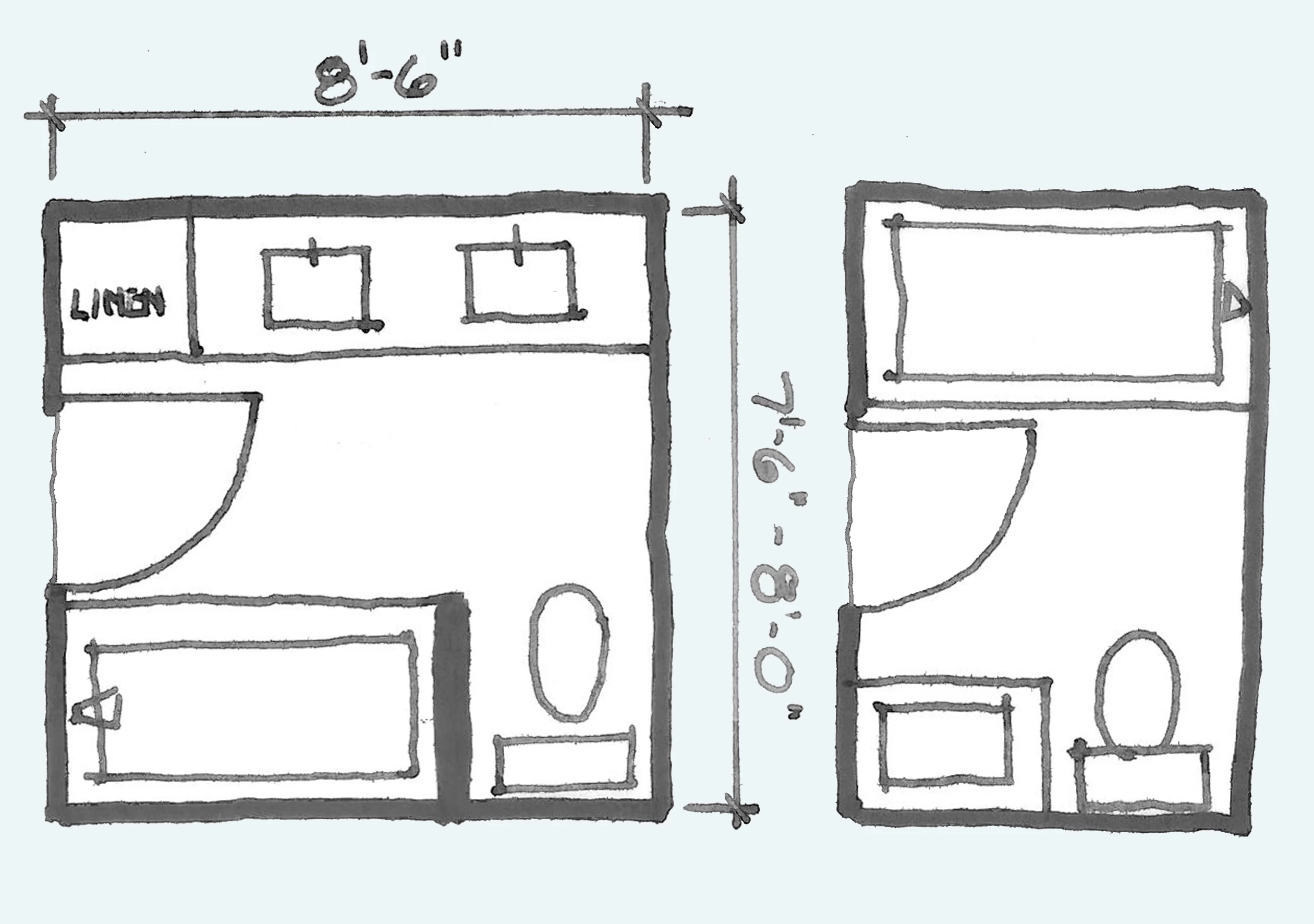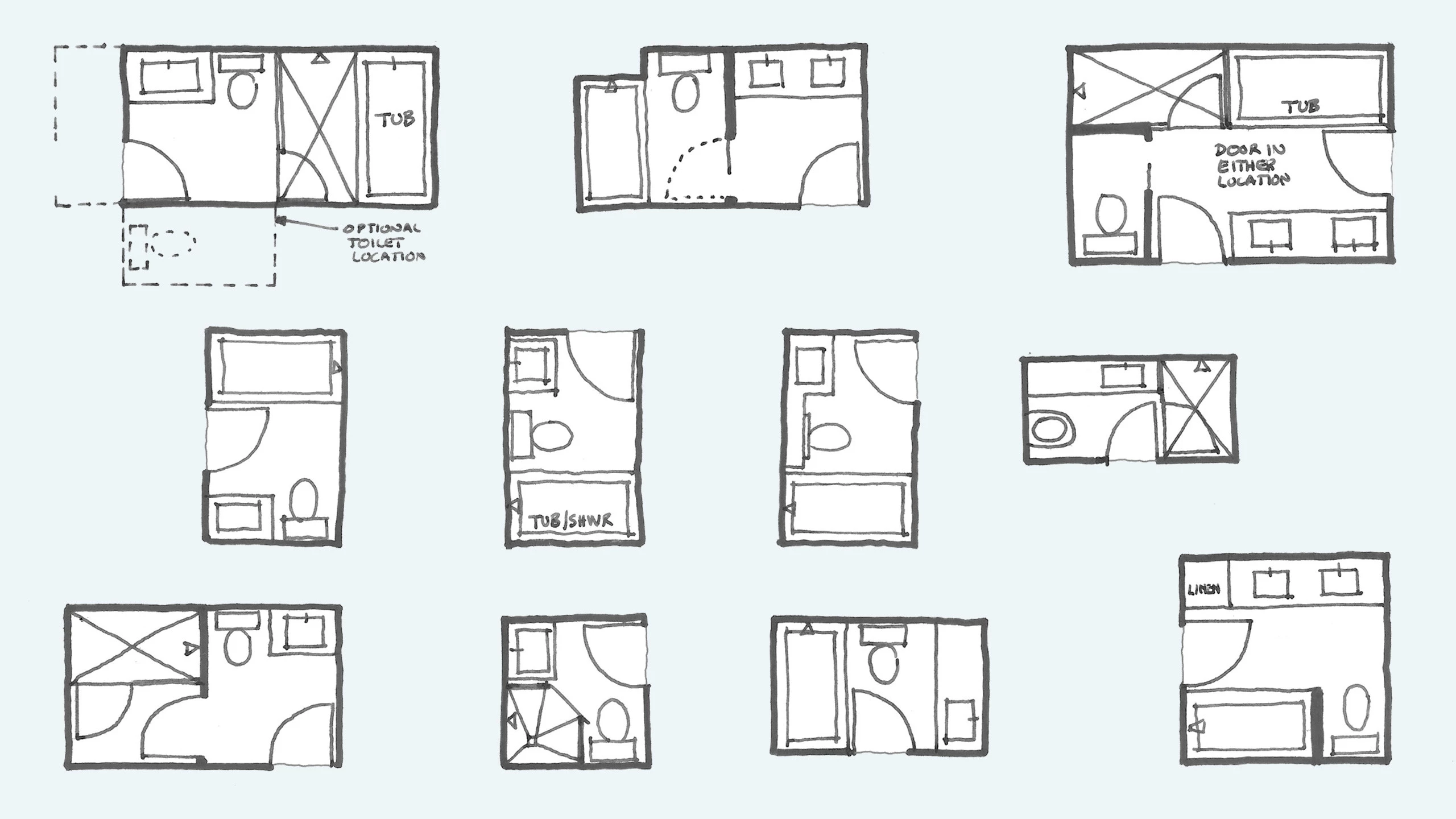Bathroom Layout Considerations for a 6×10 Space
:max_bytes(150000):strip_icc()/free-bathroom-floor-plans-1821397-16-Final-5c7691d7c9e77c0001d19c3c.png)
Designing a functional bathroom within a 6×10 footprint presents unique challenges and opportunities. While the limited space can be a constraint, it also forces creative solutions and efficient use of every square inch. This guide explores common bathroom layouts adaptable to this size, provides tips for maximizing space, and discusses strategies for creating a sense of openness in a small bathroom.
Common Bathroom Layouts for a 6×10 Space, Bathroom floor plans 6×10
A 6×10 bathroom offers a variety of layout possibilities. Here are some common configurations that can be adapted to this space:
- Single-Vanity Layout: This layout features a single vanity positioned against one wall, typically with a toilet and shower/tub combination on the opposite wall. This configuration maximizes space and allows for a comfortable flow of movement.
- Double-Vanity Layout: While challenging in a 6×10 space, a double-vanity layout can be achieved by using smaller vanities and minimizing the width of the walkway between them. This layout is ideal for couples or families who need ample counter space.
- L-Shaped Layout: An L-shaped layout places the vanity and toilet along two adjacent walls, creating a small alcove for the shower/tub. This configuration is particularly useful for maximizing floor space and creating a sense of separation between the different bathroom zones.
- Corner Layout: This layout positions the shower/tub in one corner of the bathroom, with the vanity and toilet along the adjacent walls. This layout is effective for creating a sense of spaciousness and maximizing usable wall space.
Maximizing Space in a 6×10 Bathroom
Space optimization is crucial in a small bathroom. The following tips can help maximize every inch:
- Choose Compact Fixtures: Opt for smaller vanities, toilets, and showerheads to minimize their footprint. Compact toilets with a smaller bowl diameter can save valuable floor space.
- Utilize Wall Space: Install wall-mounted cabinets, shelves, and towel bars to free up floor space. Consider a medicine cabinet with mirrored doors to enhance the feeling of spaciousness.
- Vertical Storage: Incorporate tall cabinets or shelves to store items vertically, maximizing storage capacity without sacrificing floor space.
- Utilize Corners: Corner shelves or cabinets are excellent for storing toiletries and other items, making the most of often-unused space.
Creating a Sense of Openness in a Small Bathroom
While a 6×10 bathroom may be small, it can still feel spacious and inviting. These strategies can help create a sense of openness:
- Light Colors and Finishes: Light colors on walls, floors, and fixtures reflect light, making the space feel larger. White or off-white paint can visually expand the room.
- Mirrors: Mirrors strategically placed on walls can reflect light and create the illusion of a larger space.
- Minimalist Design: A minimalist approach with clean lines and fewer accessories can make the bathroom feel more spacious and uncluttered.
- Open Shower: If possible, consider an open shower without a door or a frameless glass enclosure to create a sense of visual continuity.
Essential Bathroom Fixtures and Their Placement: Bathroom Floor Plans 6×10

In a 6×10 bathroom, maximizing space while ensuring functionality is crucial. Understanding the essential fixtures and their optimal placement is vital for creating a comfortable and efficient bathroom.
Typical Bathroom Fixtures and Dimensions
The following table lists common bathroom fixtures and their typical dimensions, which can help in planning the layout:
| Fixture | Typical Dimensions |
|---|---|
| Toilet | 28-30″ wide x 30-32″ deep |
| Sink | 18-24″ wide x 18-22″ deep |
| Shower | 32-36″ wide x 32-36″ deep |
| Bathtub | 30-36″ wide x 60-72″ long |
Optimal Placement of Bathroom Fixtures
The placement of fixtures within a 6×10 bathroom is crucial for maximizing space and functionality. Here are some considerations for the placement of common fixtures:
* Toilet: Ideally, the toilet should be placed against a wall to maximize space. It should be positioned far enough away from the sink and shower to allow for comfortable movement.
* Sink: The sink should be positioned near a window for natural light and ventilation. A vanity cabinet can be used to provide storage space and hide plumbing.
* Shower: The shower should be placed in a corner or against a wall to optimize space. It’s essential to ensure adequate ventilation and a waterproof surface.
* Bathtub: If including a bathtub, it’s often placed along a wall to maximize floor space. However, consider the size and shape of the bathtub as it can take up significant space.
Examples of Different Bathroom Configurations
There are various ways to configure fixtures in a 6×10 bathroom. Here are a few examples with their pros and cons:
* Linear Configuration: This layout places fixtures along one wall, creating a streamlined look. This configuration is efficient for smaller bathrooms but may limit flexibility and storage space.
* L-Shaped Configuration: This layout places fixtures along two adjacent walls, creating a more spacious feel. This configuration is suitable for larger bathrooms and allows for more storage space.
* U-Shaped Configuration: This layout places fixtures along three walls, creating a cozy and intimate feel. This configuration is best suited for smaller bathrooms and maximizes space utilization.
Design Ideas and Inspiration for a 6×10 Bathroom

A 6×10 bathroom offers a unique challenge: creating a functional and stylish space within a limited footprint. With careful planning and design, even a small bathroom can feel spacious and luxurious. This section explores various design ideas and inspiration for a 6×10 bathroom, covering different styles, color palettes, materials, and finishes.
Modern Bathroom Designs
Modern bathroom designs often prioritize clean lines, minimalist aesthetics, and a focus on functionality. A 6×10 bathroom can embrace this style with a floating vanity, sleek chrome fixtures, and a large mirror to create an illusion of space.
- Floor Plan Example: One layout option could feature a walk-in shower in one corner, a floating vanity with a rectangular sink in the opposite corner, and a toilet positioned along the side wall. The shower can be enclosed with glass panels for a seamless look.
- Color Palette: Neutral colors like white, gray, and black are common in modern bathrooms, with pops of color added through towels, rugs, or artwork.
- Materials and Finishes: Modern bathrooms often use materials like polished concrete, natural stone, or wood-look porcelain tiles for the floor and walls. Sleek chrome or brushed nickel fixtures are a popular choice.
